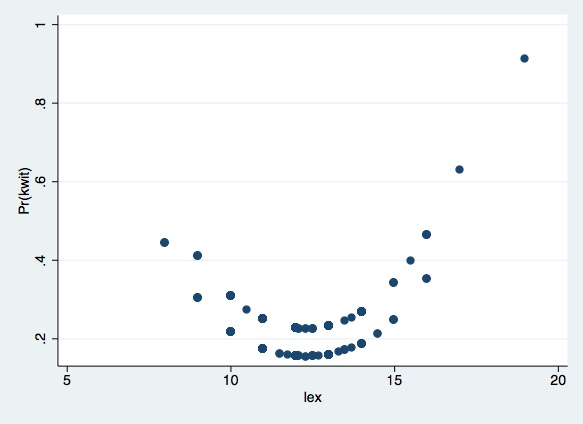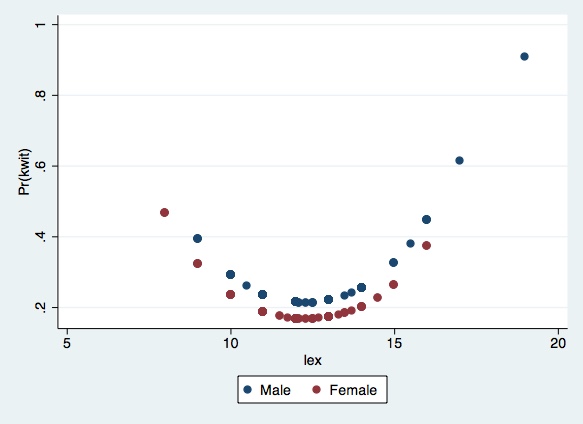e-TA 14: Binary Data Models
Welcome to a new issue of e-Tutorial. This e-TA will focus on Binary Data Models, with special enphasis on Logit and Probit regression models.1
Data
You can download the data set, called weco14.csv from the Econ 508 web site. Save it in your preferred directory.
In the previous e-TA we cleaned, prepared and saved the data in Stata format. After setting the working directory to where the data is saved, lets open it:
use weco14.dta, clearLogit estimation
Here we estimate the same logit model proposed in question 3 of PS5
\[ logit(P(quit=1))= \beta_{0} + \beta_{1} sex + \beta_{2} dex +\beta_{3} lex + \beta_{4} lex^2 \]
where \(quit=1\) if the worker wuit withing the first 6 mothns after employment, and 0 otherwise.
To estimate this model first we need to create \(lex^2\).
gen lex2 = lex^2then we are ready to estimate the model. To do so we use the logit function
logit kwit sex dex lex lex2
Iteration 0: log likelihood = -372.98741
Iteration 1: log likelihood = -340.49246
Iteration 2: log likelihood = -339.21681
Iteration 3: log likelihood = -339.21165
Iteration 4: log likelihood = -339.21165
Logistic regression Number of obs = 683
LR chi2(4) = 67.55
Prob > chi2 = 0.0000
Log likelihood = -339.21165 Pseudo R2 = 0.0906
------------------------------------------------------------------------------
kwit | Coef. Std. Err. z P>|z| [95% Conf. Interval]
-------------+----------------------------------------------------------------
sex | .4655216 .1964162 2.37 0.018 .080553 .8504903
dex | -.1020059 .0147527 -6.91 0.000 -.1309207 -.0730911
lex | -1.967471 .6398749 -3.07 0.002 -3.221603 -.7133392
lex2 | .079972 .0255483 3.13 0.002 .0298982 .1300457
_cons | 14.98417 4.080481 3.67 0.000 6.986576 22.98177
------------------------------------------------------------------------------
This is equivalent to estimate:
\[ Pr(kwit=1)=\frac{exp(x_{j} \beta)}{(1+exp(x_{j}\beta))} \]
The results above show that, ceteris paribus, workers with higher dexterity are less likely to quit, while males (sex=1) have a bigger tendency to quit than females (sex=0). In other words, positive coefficients contribute to increase the probability of quitting, while negative coefficients, to reduce it.
To draw a picture of the probability of quitting as a function of years of education, holding everything else constant (e.g., at their mean value), you need first to ask for mean of dexterity for the pooled sample, and then you can do it for males and females.
sum dex
local mean_dex = r(mean)
sumdex if sex==1
localmean_dex_male = r(mean)
sumdex if sex==0
localmean_dex_fem = r(mean)
Thus, let’s ask for the expected value of the probability of quitting conditioned to dexterity being hold at the pooled mean value:
preserve
replacedex = `mean_dex'
predict p_hat
scatter p_hat lex
restore

In the graph above you see two different curves -- one for male
(upper curve) and another for female (lower curve). This happens
because we left all explanatory variables constant at their means (in
our case, only dex was fixed), but we had to leave sex at its
original values (because the average of the dummy variable does not
make much sense in this case).
You can do this for males and females also. Next you are asked to examine better the effect of gender. A first suggestion is to tabulate sex and kwit:
tab sex kwit
| kwit
sex | 0 1 | Total
-----------+----------------------+----------
0 | 235 61 | 296
1 | 287 100 | 387
-----------+----------------------+----------
Total | 522 161 | 683
In the table above you can see that 61 out of the existing 296 females in this sample are quitters, while 100 out of 387 males are quitters. So, the proportion of male quitters (56.6%) is greater than the proportion of female quitters (43.3%).
Next you can draw graphs of the expected probability of quitting for each gender, using their respective dexterity means. In R, we can ask for the graphs as follows:
preserve
replace dex = `mean_dex_male' if sex==1predict phat_male if sex==1
replacedex = `mean_dex_fem' if sex==0predictphat_fem if sex==0
twoway (scatter phat_male lex) (scatter phat_fem lex), legend(label(1 "Male") label(2 "Female"))
restore

Besides the graphical analysis, you can also test for the shape of the education effect, by introducing the variables \(sex*lex\) and \(sex*lex2\) in the model, and checking their significance.
Next you are asked to evaluate the Logit specification by computing the Pregibon diagnostic. The first step is to generate the predicted probabilities of quitting, called p, and compute \(g_a\) (parameter that controls the fatness of tails) and \(g_d\) (parameter that controls symmetry):
logitkwit sex dex lex lex2
predict p
genga=.5*(log(p)*log(p) - log(1-p)*log(1-p))
gengd=- .5*(log(p)*log(p) + log(1-p)*log(1-p))
Finally you run an extended Logit model, including the variables \(g_a\) and \(g_d\):
logitkwit sex dex lex lex2 ga gd
Iteration 0: log likelihood = -372.98741
Iteration 1: log likelihood = -338.3799
Iteration 2: log likelihood = -337.12636
Iteration 3: log likelihood = -337.11333
Iteration 4: log likelihood = -337.11333
Logistic regression Number of obs = 683
LR chi2(6) = 71.75
Prob > chi2 = 0.0000
Log likelihood = -337.11333 Pseudo R2 = 0.0962
------------------------------------------------------------------------------
kwit | Coef. Std. Err. z P>|z| [95% Conf. Interval]
-------------+----------------------------------------------------------------
sex | .1048297 .5132355 0.20 0.838 -.9010934 1.110753
dex | -.0271078 .106906 -0.25 0.800 -.2366397 .1824241
lex | .1857418 2.322958 0.08 0.936 -4.367172 4.738656
lex2 | -.008141 .0945127 -0.09 0.931 -.1933824 .1771004
ga | -2.348945 1.946928 -1.21 0.228 -6.164854 1.466965
gd | -2.097206 1.422105 -1.47 0.140 -4.88448 .6900683
_cons | -1.084255 17.74923 -0.06 0.951 -35.8721 33.70359
------------------------------------------------------------------------------
And test their joint significance:
test ga gd
( 1) [kwit]ga = 0
( 2) [kwit]gd = 0
chi2( 2) = 3.26
Prob > chi2 = 0.1958
Please send comments to bottan2@illinois.edu or srmntbr2@illinois.edu↩